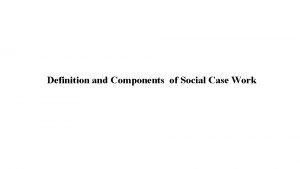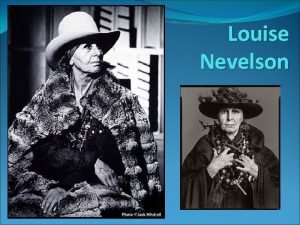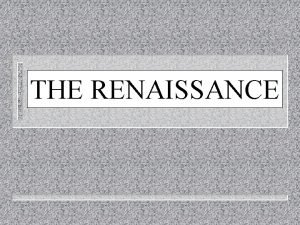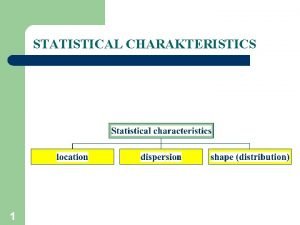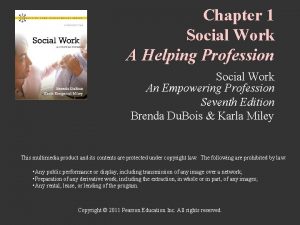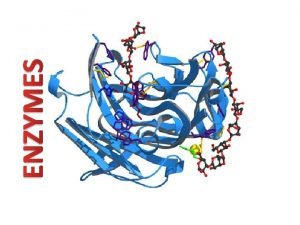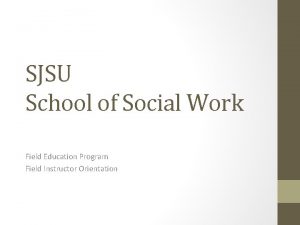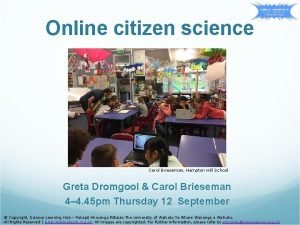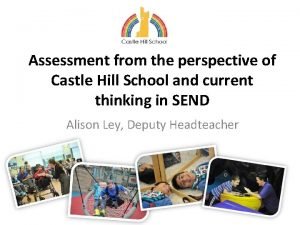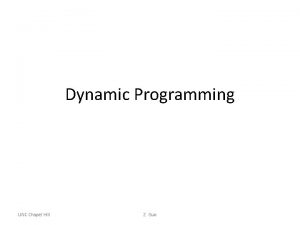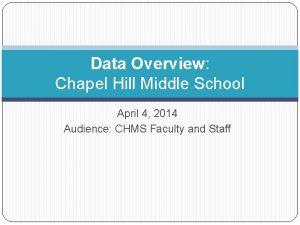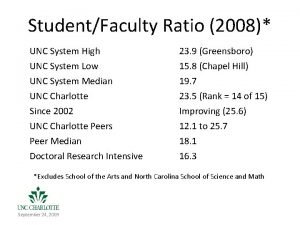UNC Chapel Hill School of Social Work Clinical

























































- Slides: 57

UNC Chapel Hill School of Social Work Clinical Institute The Relevance of DBT to Trauma Work DAY 2 Two-Day Training with Deborah Barrett, Ph. D, LCSW & Robin Sansing, MSW, LCSW

Day 2 Agenda 9: 00 Welcome & Mindfulness 9: 10 I. Case conceptualization 10: 15 BREAK 10: 30 II. Q & A and case consultation 12: 00 LUNCH 1: 00 III. DBT skills 2: 30 Break 2: 45 IV. DBT Skills 4: 00 V. Summation, discussion, resources 4: 30 END

Mindfulness Nonjudgmental Stance

Questions from yesterday?

I. Case conceptualization (case formulation)

Elements of Case Formulation • Demographic history & thorough symptom assessment • Primary targets – according to stage of treatment • Secondary targets • Assessment of skills and skills deficits • Uncovering “controlling variables” Case conceptualization should be revised regularly

dialectical dilemmas Secondary targets Emotional vulnerability Unrelenting crisis Active passivity Apparent competence Inhibited grief Self-invalidation

Adolescent secondary targets Excessive leniency Normalizing pathological behavior Forcing autonomy Fostering dependence Authoritarian control Pathologizing normative behavior

Case formulation • Based on repeated BCAs and in-session observations • Identify controlling variables and typical patterns that set off, lead to or maintain the problem behavior. Include operating hypotheses – “What’s getting in way? ” • EXAMPLES: secondary targets, skill deficits, invalidation, problematic cognition, contingency/reinforcement patterns “controlling variables” • Opportunity to see what you don’t yet know • Formal case formulation and “mini-case-formulations” (do often, include date) *Guides your treatment plan. . .

Samantha developing a Case Formulation

Conceptualization comes through finding common links through repeated chains

Samantha – BCA of NSSIB Cutting forearm Vulnerabilities Tired, food deficit, invalidated by mother Triggering event Friend left • • • Skills? • Relationship with emotions? Contingencies & reinforcement? • Consequences: • Felt relief • Exhaustion • Didn’t want to wake up Links: “I’m all alone” “My friend might die” Scared, sad, hopeless Noticed urge to cut Stared at razor Couldn’t think of alternative “Fuck it”

Samantha – BCA (therapy interfering behavior) Called to quit therapy Vulnerabilities Hurting, Tired Triggering event • Spoke about • car accident in therapy • Skills? • Relationship with emotions? • Contingencies & reinforcement? • Consequences: • Felt relief about Links: giving up “I don’t want to be doing this” • Later therapist Felt raw, exposed, guilt, helped me calm shame, self-disgust down Held it together until end of session Trouble breathing “I can’t stand it” Stepped into traffice

Case formulation: Samantha • Factors that control targeted problem: 1. Skill deficit? Teach relevant skill. q Mindfulness q Emotion Regulation q Distress tolerance q Interpersonal effectiveness 2. What else is getting in the way? • Secondary targets: q Active passivity q Emotion reactivity q Unrelenting crisis q Apparent competence q Self-invalidation q Inhibited grieving

In Pairs: Your Turn Fill out your own case conceptualization Ø Select a current (or past) client of yours

II. Q & A Case conceptualization? Linking to treatment planning? DBT treatment in general? Case consultation?

III. DBT Skills Core Mindfulness & Interpersonal Effectives

Core Mindfulness

Goals of module: • To learn to observe one’s thoughts, feelings, and sensations without reacting to them • To increase control of one’s experience • To cultivate a non-judgmental stance • To participate in life with awareness (rather than impulsive or mood-dependent behaviors) • To experience reality as it is

Core Mindfulness – States of mind • Awareness of each “mind state” sensation = sensation Cultivate “Wise Mind” • Balanced point of view • intersection of reason and emotion states • Embraces dialectic sensation = sensation Reason Mind Wise Mind Body Mind Emotion Mind

Core Mindfulness – What and How Skills What to do: • Observe • Describe • Participate How: • Nonjudgmentally • One-mindfully • Effectively

Interpersonal Effectiveness

Interpersonal Effectiveness →What is the goal of the communication? Objective Effectiveness What is my objective – What do I need to get out of this interaction? Relationship Effectiveness How do I want the other person to feel about me after our interaction? Self-respect Effectiveness How do I want to feel about myself after our interaction? *Walk the Middle Path – Maintaining balance in relationships*

Objective Effectiveness DEAR What • Describe the current situation • Express feelings and opinions • Assert or by asking or saying no • Reinforce How (WO)MAN • Wise mind place • One mindfully • Mindful of objectives • Appear confident • Negotiate alternative solutions

Relationship Effectiveness • Gentle manner • Interested in the other person • Validate the other person without judging • Easy manner with humor

Self-respect Effectiveness FAST • be Fair • no Apologies • Stick to values • be Truthful

In pairs: Practice your DEAR (WO)MAN Your turn

IV. DBT Skills Emotion Regulation & Distress Tolerance

Emotion Regulation

Emotion Regulation Skills • Understanding & Naming Emotions • Changing Unwanted Emotions • Reducing Vulnerability to Emotion Mind • Managing Extreme Emotions

Emotion Regulation Start with → All emotions are VALID * May or may not be justified/warranted Practice NAMING emotions

Components of Emotions

Components of Emotions or “the Wave Seth Axelrod

Changing unwanted emotions → Opposite Action FEAR ………………Approach ANGER ……………Gently avoid/Be kind ENVY ………………Gratitude LOVE ………………Avoid/Distract SADNESS …………. Get active/Avoid avoiding SHAME/GUILT ……Make public/Repeat

Distress Tolerance

The ability to tolerate and survive crises without making things worse

Pain+ Non-acceptance = Suffering & Being Stuck Holding an Open Heart Towards What Is. Pain + Acceptance = Ordinary Pain & the Possibility of Moving Forward

Distress Tolerance Skills • Crisis Survival Skills • Reality Acceptance Skills • Skills when the crisis is addiction

Crisis survival skills with Distraction • Wise Mind ACCEPTS • Activities • Contribute • Comparisons • Change your Emotions • Push away thoughts • Think of other things • S ensations IMPROVE the moment with cognitive techniques: • Imagery • Meaning • Prayer • Relaxation • One-thing-in-the-moment • Vacation • Encouragement

Distress Tolerance Skills: Self soothe (with five senses)

Crisis survival with Pros & Cons

Reality Acceptance skills: - Radical Acceptance - Willingness - Turning the mind

Distress Tolerance: Willingness practices Small smile Willing hands, posture Willingness is saying yes to the mystery of being alive in each moment. Willfulness is saying no, or perhaps more commonly, “yes, but. . . ” Source: Gerald May, 1982, in Care of Mind-Care of Spirit: Psychiatric Dimensions of Spiritual Direction, San Francisco: Harper and Row, p. 6.

SKILLS MODULES: Q&A

Summary

DBT Review Ways to approach any problem • Solve the problem • Change your perception of the problem • Radically accept the problem • Stay miserable Primary Targets (hierarchy -levels) • Life-threatening behaviors (SI, NSSI) • Therapy-interfering behaviors (TIB) • Quality of life behaviors (QL) • Skills acquisition Components of treatment • Individual therapy • Skills group (CM, IPE, ER, DT) • Phone skills coaching • Consult team Session structure: 1. Review Diary Card 2. Attention to target hierarchy 3. Chain Analysis on highest target 4. Weave in Solution Analysis 5. Move down hierarchy → current life situations Stages of therapy: IV. Incompleteness Capacity for sustained joy III. Problems in living Ordinary happiness & unhappiness II. Quiet desperation Emotional experiencing I. Severe Behavioral Dysregulation Control

DBT Review (cont. ) Secondary targets (dialectical dilemmas): Emotional vulnerability Unrelenting crisis Active passivity Apparent competence Selfinvalidation Inhibited grief Therapist characteristics Oriented to Unwavering change Benevolent centeredness demanding Compassionate flexibility Nurturing Oriented to acceptance Dialectical approach: • Acceptance (validation) & Change (problem solving) • Synthesis (and/both) • Transactional (person & environment)

DBT Review (cont. ) Assumptions about patients Assumptions about therapists Ø People are doing the best they can. Ø People want to improve Ø People must learn new behaviors both in therapy and in the context of day-to-day life. Ø People cannot fail in DBT Ø People may not have caused all of their problems, but they have to solve them anyway. Ø People need to do better, try harder and be more motivated to change. Ø The lives of people who are suicidal are unbearable as they are currently being lived. ü The most caring thing a therapist or treatment provider can do is help people change in ways that bring them closer to their own ultimate goals. ü Clarity, precision and compassion are of the utmost importance. ü The treatment relationship is a real relationship between equals. ü Principles of behavior are universal, affecting clinicians no less than clients. ü Treatment providers need support ü Treatment providers can fail.

DBT Review (cont) Behaviors to Decrease Core Strategies = Validation + Problem Solving Skills / behaviors to increase: • Interpersonal chaos • Labile emotions and moods • Impulsiveness • Confusion about self and cognitive dysregulation • Quality-of-life interfering behaviors • Core mindfulness • Interpersonal effectiveness • Emotion regulation • Distress tolerance • Self-management and life skills Dialectical Strategies: Change Strategies: • Contingency management • Skills • Exposure • Cognitive Modification • Entering the paradox • Metaphor • Activating Wise Mind • Devil’s advocate • Making lemonade • Extending • Allowing natural change • Dialectical assessment

Core Strategies = Validation + Problem Solving Levels of Validation: Being Present Accurate Reflection Reading Cues History Normalizing Radical genuineness Validation Strategies � Emotional validation � Behavioral validation � Cognitive validation � Cheerleading https: //www. youtube. com/watch? v=-4 EDhd. AHr. Og

Core Mindfulness • States of Mind • “What” skills • Observe • Describe • Participate • “How” skills • One-mindfully • Non-judgmentally • Effectively • Loving kindness

Using DBT with a variety of populations

Case explorations • • What stage of treatment are they in? Primary target behaviors? Secondary targets? Life worth living goals? Acceptance, change, dialectical strategies? Skill areas to target? Consultation?

Resources • • Articles on DBT & Trauma Texts and websites Local resources Certification:

DBT Kahoot!

https: //dbt-lbc. org/

Closing awareness & From Debbie & Robin Thank you !
 Claire dees
Claire dees Unc ch computer science
Unc ch computer science Ohre unc
Ohre unc Unc chapel hill ib credit
Unc chapel hill ib credit Unc chapel hill connectcarolina
Unc chapel hill connectcarolina Consenso de chapel hill
Consenso de chapel hill Enrolled agent chapel hill, nc
Enrolled agent chapel hill, nc Rituxvas
Rituxvas Wesley chapel high school
Wesley chapel high school Chapel end primary school
Chapel end primary school Social group work objectives
Social group work objectives What is social case work?
What is social case work? Comparison of the four gospels chart
Comparison of the four gospels chart Dawn's wedding chapel iv, 1959 - 1960
Dawn's wedding chapel iv, 1959 - 1960 Hope chapel apex
Hope chapel apex Sistine chapel exterior photos
Sistine chapel exterior photos Charakteristics
Charakteristics Chapel rock camp
Chapel rock camp Mixed woodland map symbol
Mixed woodland map symbol Radiating chapel
Radiating chapel Giotto di bondone arena chapel
Giotto di bondone arena chapel Chapel hpc
Chapel hpc Nelson chapel church of christ
Nelson chapel church of christ 1 corinthians 10 23-33
1 corinthians 10 23-33 Cerasi chapel
Cerasi chapel Sistine chapel is located in which country
Sistine chapel is located in which country Social welfare vs social work
Social welfare vs social work Principles of social action in social work
Principles of social action in social work Relation of social work with other social sciences
Relation of social work with other social sciences Global agenda for social work and social development
Global agenda for social work and social development Social work: an empowering profession 9th edition chapter 1
Social work: an empowering profession 9th edition chapter 1 How enzymes work mcgraw hill
How enzymes work mcgraw hill School social work ethical dilemmas
School social work ethical dilemmas Professional boundaries in social work quiz
Professional boundaries in social work quiz School social work in pakistan
School social work in pakistan University of texas at arlington school of social work
University of texas at arlington school of social work Sjsu school of social work
Sjsu school of social work Fau msw program
Fau msw program Boston university school of social work
Boston university school of social work Wmu school of social work
Wmu school of social work University of memphis msw
University of memphis msw Transcultural perspective sjsu
Transcultural perspective sjsu Salem state university school of social work
Salem state university school of social work Apa itu social thinking
Apa itu social thinking Social thinking social influence social relations
Social thinking social influence social relations Whrhs.org
Whrhs.org Cherry hill school district+sfra
Cherry hill school district+sfra Primary writing castle hill
Primary writing castle hill Tex hill middle school athletics
Tex hill middle school athletics Laurel hill secondary school
Laurel hill secondary school Bunker hill middle school
Bunker hill middle school River hill high school principal
River hill high school principal Parish hill high school
Parish hill high school Pokapū akoranga pūtaiao
Pokapū akoranga pūtaiao Castle hill school huddersfield
Castle hill school huddersfield Beech hill elementary school
Beech hill elementary school Sharon hill school district
Sharon hill school district Mill hill county sixth form
Mill hill county sixth form











